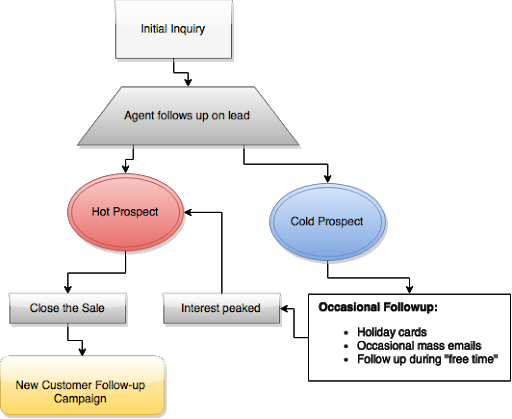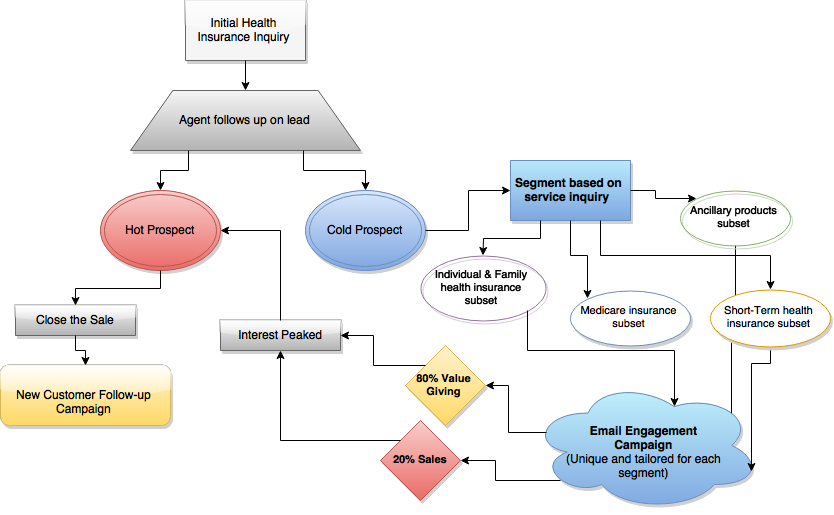
Reading Time: 6 minutes
Most businesses today run on email. Whether you are an independent agent or part of a larger insurance agency, you use email to boost sales and marketing efforts, coordinate schedules, collaborate on projects, and share information.
According to the experts at Constant Contact, the ROI for email marketing is $36 for every $1 spent, and automated emails remain a leading digital marketing trend in 2022.
With that in mind, if you want to grow your business without breaking the bank, you’d be wise to double down on your insurance email marketing efforts. Email can help you nurture existing clients, but you can also use email to convert cold insurance leads. Depending on how effective your approach is, you may be able to land a ton of new clients without doing that much heavy lifting.
Before we explain how you can do that, let’s take a step back and get some terms straight.
What Are Cold Insurance Leads?
A cold lead is someone who isn’t planning to buy insurance from you. Maybe the person hasn’t heard of your company, maybe their insurance needs have already been met by someone else, or maybe the person doesn’t even know they have insurance needs beyond the typical health insurance most of us get through work.
Just because someone might be a cold lead right now doesn’t necessarily mean that they will stay that way forever. With the right strategy and tools in place, you can gently nudge cold leads toward buying insurance from you.
That strategy starts with creating a method of insurance marketing and sales that uses a follow-up funnel to ensure your business has a plan of attack that details how you will approach each cold lead moving forward.
What Is the Follow-Up Funnel?
The follow-up funnel outlines how you’re going to engage with cold leads moving forward. If your business is like most others, you probably drop cold leads into a big, old bucket filled with all of the other cold leads and then reach out to them on a periodic basis using weak and ineffective communications.
Sound familiar? If so, your follow-up funnel probably looks something like this:

Although this chart gives you the ability to convert cold leads back into hot ones, there’s a lot more you can do to increase the chances that your follow-up funnel actually leads to sales. If your goal is to use email to convert as many cold leads as you can, you can get the results you’re hoping for by using email segmentation.
Need some help building out your funnel? Check out these free templates for insurance agents:
What Is Email Segmentation?
Email segmentation is the process of grouping your subscribers into smaller segments based on specific traits or characteristics. For example, you might group all of your Medicare-age cold leads into one bucket, all of your cold leads in New York City into another bucket, and all of your cold leads who you suspect are interested in ancillary insurance products into yet another.
In this light, email segmentation helps you personalize your funnel, with subscribers getting information that is useful to them in their inboxes at whatever intervals you decide. This increases the chances that you’ll be able to convert your cold leads over time while also reducing the likelihood that people will unsubscribe from your list, complain about the messages they’re receiving, or—worse yet—mark you as spam.
Now that you have a better idea about how you can use email segmentation to grow your insurance business without having to exert a ton of effort, let’s turn our attention to what, specifically, you can do to kick off your email segmentation efforts.
How to Begin Email Segmentation
Imagine that there’s a figurative insurance agent named Irene who offers a variety of health-related services to her insurance clients. Irene, who is smarter than the average agent, has evolved far beyond the common yet overly simplistic follow-up funnel shown above.
Irene is intelligent. She knows that most people on her list have no idea who she is or what she’s about. When it comes to meeting their insurance needs, most of these people would prefer to work with someone they have some level of affiliation with—such as a friend, neighbor, or relative.
Instead of ignoring this reality or even fighting against it, Irene plans to use email segmentation to route her cold leads through a follow-up funnel. That way, she can work to “create” that affiliation with her cold leads and, over time, convince them to do business with her.
To be sure, doing so is a tricky endeavor. Irene will need to take the time to create great emails, and she’ll need to use a powerful email service that enables her to automate much of the process.
Although it’s a bit of a challenge, Irene knows that her efforts will pay off because she will be able to convert more and more cold leads into hot ones with the right approach—thus making all of the effort worthwhile. Irene is especially excited at the prospect of writing the emails and setting up the campaigns because once that’s over, there’s little, if any, work for her to take care of to maintain the process.
After examining her leads, Irene decides to segment her email list into four distinct buckets:
- Medicare prospects
- Individual and family plan prospects
- Ancillary product prospects
- Short-term service prospects
Now that she knows which segments she’s going to target, Irene is going to start building separate follow-up marketing campaigns for each type of cold prospect. This, of course, will take a little bit of time. But the benefits of email segmentation done the right way are too good to pass up, so she knows the time will be well spent. When done correctly, email segmentation will enable Irene to send more frequent messages, develop deeper relationships with each prospect, reduce unsubscribes, and ultimately increase conversion rates.
The Pareto Principle and Email Engagement
Irene knows the Pareto principle, which suggests that 20 percent of our efforts will produce 80 percent of our results. She also knows how annoying it can be when a salesperson sends out email after email trying to get you to make a purchase. Taking it together, Irene decides that 20 percent of her emails are going to be sales-focused, and 80 percent will focus on engaging her audience.
Sales emails will include incentives and special information about low insurance rates, packages, and other messaging geared at getting a policy signed. For example, Irene might write about how buying insurance through an agent doesn’t cost more, the costs associated with not going through an agent and all the hassle that comes with it, and how licenses and certifications help make someone more trustworthy.
As you can see, there are several ways you can subtly sell your business without directly asking people to sign up! By analyzing the sales flow, from new prospect to client, you can find numerous sales points and benefits that can inform the content of these emails.
What about the engagement emails?
Irene is going to use these emails to build a powerful follow-up campaign that provides value and establishes her agency as credible. Content here might focus on educating prospects about specific insurance policies that they have inquired about, insurance claim horror stories and how she easily handled them, and general tips and advice.
All of this content would be catered toward the segments Irene identified earlier in the process. For example, Medicare prospects might be given tips on aging, whereas family plan prospects could receive tips on children’s health.
Add it all up, and Irene’s funnel now looks something like this:

Although Irene recognizes that marketing emails don’t often come from insurance agents, she knows that a never-ending stream of sales-oriented emails will turn people off, whereas engagement emails will help her develop a community and, over time, warm up her leads from cold to hot. You never know when a cold prospect will decide to check out an email you send about a crazy industry horror story only to then realize they need to buy insurance and send business your way.
Insurance Email Marketing Templates For Conversion Success
Irene knows that effective emails are well-written and full of great content. But she also knows that there are other important considerations, such as:
- Follows the CAN-SPAM Act guidelines
- The email’s branding, including text, color scheme, and more
- Ensuring that your contact information is always prominently displayed
- Ensuring that unique calls to action targeted to the associated segment are added to each message
Beyond that, she knows that great emails:
- Start with an engaging subject line
- Are personalized as much as they can reasonably be
- Include links to competitive quotes for insurance products you know the reader is interested in
- Are short and sweet—no one is going to read a 3,000-word message
- Are timely—no one is going to appreciate learning that open enrollment actually ended two weeks ago
Irene understands that each of these elements is important, but she knows that including quotes, proposals, or—even better—a link that enables a prospect to get a quote themselves is probably the most important element. Doing so allows her to get more prospects into her pipeline even if they aren’t necessarily ready to buy.
Irene also knows that she’s going to need to follow up on a regular cadence but has to balance that with not being overly communicative (i.e., annoying!). It’s a complicated web, with many moving parts. But getting all of those parts in order is well worth the battle. Irene understands that, and she hopes you do, too.
-1.png?width=1920&height=1200&name=QT-Logo-Big%20(1920)-1.png)


